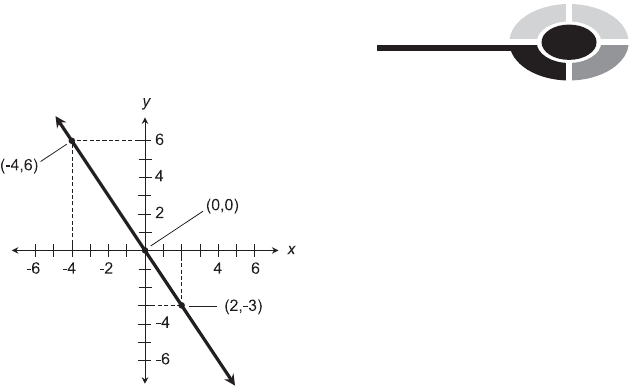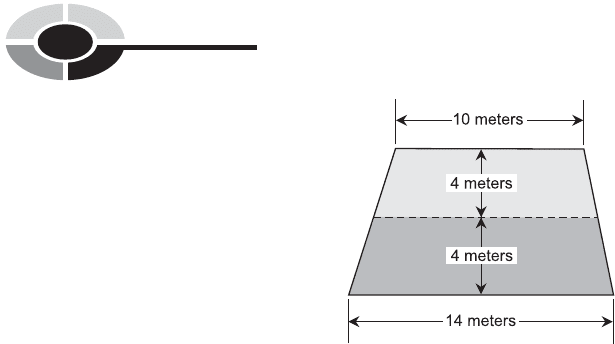Gibilisco S. Everyday Math Demystified: A Self-Teaching Guide
Подождите немного. Документ загружается.


(c) time per unit distance
(d) acceleration per unit time
(e) velocity multiplied by time
23. Any radioactive material has a specific period of time known as its
half-life, over which its radioactivity drops by 50%. Suppose the
half-life of element X is 100 years. Right now the radiation intensity
from a sample of element X is at a certain level. In 100 years, the
element X will be 50% as radioactive as it is right now. After another
100 years, the radioactivity of the element X will drop by another
50%. This process will repeat, century after century, eon after
eon. The radiation-intensity levels of any given sample of element
X, measured in constant ‘‘radiation units (RU)’’ at intervals of 100
years:
(a) increase without limit
(b) alternate between positive and negative
(c) comprise a geometric progression
(d) add up to zero
(e) converge toward 1
24. Suppose you want to check the floor in a room to see if it is perfectly
horizontal. You know the floor is perfectly flat throughout the room.
You have a carpenter’s level with which you can check to see if any
particular line along the floor is horizontal. What is the minimum
number of readings you must make with the level in order to know
whether or not the floor is perfectly horizontal?
(a) 1
(b) 2
(c) 3
(d) 4
(e) 5
25. Which of the following can be a unit of acceleration magnitude?
(a) Meters per second.
(b) Seconds per meter.
(c) Meters per second squared.
(d) Seconds per meter squared.
(e) Degrees per meter squared.
26. Imagine a room whose floor and ceiling are perfectly square, and
whose four walls are all perfect rectangles. Imagine one corner of
this room, where two walls intersect the floor. There are three line
segments that come together at this corner: the line segment where
Test: Part 4 391

the two walls intersect, the line segment where one wall intersects
the floor, and the line segment where the other wall intersects the
floor. At the corner where they all come together, these three line
segments are
(a) mutually parallel
(b) mutually perpendicular
(c) mutually skewed
(d) mutually equilateral
(e) none of the above
27. A flat geometric plane in 3D space can be uniquely defined by
(a) a point in the plane and a vector perpendicular to the plane
(b) three points that do not all lie on the same straight line
(c) two parallel straight lines
(d) two intersecting straight lines
(e) any of the above
28. Suppose you have a jar in which you keep change that accumulates
in the course of your shopping adventures. Every day, you put 76
cents into the jar. The amount of money in the jar increases day
by day, according to
(a) an arithmetic progression
(b) a geometric progression
(c) a logarithmic progression
(d) an exponential progression
(e) a convergent progression
29. Any radioactive material has a specific period of time known as its
half-life, over which its radioactivity drops by 50%. Suppose the half-
life of element Y is 80,000 years, someone has just handed you a sam-
ple of it, and the radiation level from it is 128 ‘‘radiation units (RU).’’
In 80,000 years, the sample will be half as radioactive as it is today.
After another 80,000 years, the radioactivity will go down by half,
again. This decay process will go on essentially forever. Suppose
the maximum safe level for human exposure to any radioactive sub-
stance is 16 RU. How long will it be before it’s no longer dangerous
to hang around the piece of element Y you’ve just been given?
(a) 240,000 years.
(b) 160,000 years.
(c) 80,000 years.
(d) 40,000 years.
(e) 20,000 years.
PART 4 Math in Science
392

30. What would Fig. Test 4-3 most likely represent?
(a) The frequency setting of a hi-fi stereo radio receiver.
(b) The direction in which a car or truck drives down a level street.
(c) The direction in which a broadband satellite Internet dish is
pointed.
(d) The compass bearing of a hiker in the wilderness.
(e) The acceleration of a speedboat on a lake.
31. In Fig. Test 4-3, what do
x
,
y
, and
z
represent?
(a) Direction cosines.
(b) Direction angles.
(c) Compass bearings.
(d) Elevation angles.
(e) Azimuth bearings.
32. In Fig. Test 4-3, what is represented by the lowercase, boldface letter a?
(a) A ray of light.
(b) An exponent.
(c) A logarithm.
(d) A scalar.
(e) A vector.
33. What is another thing that Fig. Test 4-3 might depict?
(a) The velocity at which a missile is fired.
(b) Sunlight shining down on the surface of the earth.
Fig. Test 4-3. Illustration for Part Four Test Questions 30 through 34.
Test: Part 4 393

(c) The motion of a train along a level track.
(d) The speed of the wind in a hurricane.
(e) The time and temperature in a certain place.
34. The diagram in Fig. Test 4-3 portrays?
(a) 1 spatial dimension.
(b) 2 spatial dimensions.
(c) 3 spatial dimensions.
(d) 4 spatial dimensions.
(e) 5 spatial dimensions.
35. The human ear and brain perceive the loudness of a sound
(a) in proportion to the square of the sound power
(b) in proportion to the base-10 exponential of the sound power
(c) in proportion to the base-e exponential of the sound power
(d) in proportion to the logarithm of the sound power
(e) in inverse proportion to the sound power
36. Suppose we are told the following sequence S is an arithmetic
sequence:
S ¼ 80ó 75ó xó yó zó 55ó 50
What is the difference between x and z?
(a) 5
(b) 10
(c) 15
(d) 20
(e) It cannot be determined without more information.
37. Suppose you are told that the intensity of some effect Y varies
according to the 3/2 power of the strength of some other effect X.
If the strength of effect X doubles, by what factor does the intensity
of effect Y increase?
(a) It does not change.
(b) It doubles.
(c) It quadruples.
(d) It increases by a factor of the square root of 8.
(e) More information is needed to answer this question.
38. Suppose you are building a coffee table. Your friend wants it to have
four legs attached to the table at the corners of a square. But you
want it to have only three legs, attached to the table at the vertices
of an equilateral triangle. You know that a three-legged table
PART 4 Math in Science
394

won’t wobble, even if the floor is irregular or if the legs don’t all turn
out to be exactly the same length. On what geometric principle is this
fact based?
(a) A vector normal to a flat plane cannot lie in that plane.
(b) Two intersecting, straight lines uniquely define a flat plane.
(c) Three points, not all on the same line, uniquely define a flat
plane.
(d) Four points can lie in the same plane, but this is not always true.
(e) Four points can lie at the corners of a square, but this is not
always true.
39. Suppose your computer receives (unknown to you) an e-mail worm
that causes it to automatically send the same message to 100 other
computers. Ninety percent (90%) of the computers that receive this
e-mail block it out, but the other 10% get it and execute its nefarious
instructions. This process continues indefinitely, with one iteration
taking place every minute. The number of these useless, unethical,
illegal e-mail messages clogging up the Internet increases, per unit
minute, according to
(a) an arithmetic progression
(b) a logarithmic progression
(c) a geometric progression
(d) a quadratic progression
(e) a cubic progression
40. Suppose you step on the ‘‘gas pedal’’ of a high-performance car while
you take a banked curve on a race track. The magnitude and direc-
tion of the acceleration of the car at a particular instant in time can
be fully defined as
(a) a vector
(b) a logarithm
(c) a constant
(d) a trigonometric function
(e) an exponent
Test: Part 4 395

Final Exam
Do not refer to the text when taking this test. You may draw diagrams or
use a calculator if necessary. A good score is at least 75 correct. Answers
are in the back of the book. It’s best to have a friend check your score the
first time, so you won’t memorize the answers if you want to take the test
again.
1. Which of the following statements is false?
(a) A dependent variable can change in value, but its value is affected
by at least one other factor.
(b) An independent variable can change in value, but its value is not
influenced by anything else in a given scenario.
(c) A mathematical function is always a mathematical relation.
(d) A mathematical relation is always a mathematical function.
(e) A function always has at least one dependent variable.
2. What is the product of 2/3 and 4/5?
(a) 6/15
(b) 8/15
(c) 3/4
396
Copyright © 2004 by The McGraw-Hill Companies, Inc. Click here for terms of use.

(d) 1
(e) 22/15
3. What is the equation shown by the straight line in Fig. Exam-1?
(a) 3x þ 2y ¼ 0
(b) 2x þ 3y ¼ 0
(c) 2x 3y ¼ 0
(d) 4x 6y ¼ 0
(e) 6x þ 3y ¼ 0
4. Consider the following equation:
ð y
2
2y þ 1Þð y þ 4Þð y þ 5Þð y þ 6Þ¼0
How many real-number solutions are there to this equation?
(a) 1
(b) 2
(c) 3
(d) 4
(e) 5
5. It is known that 1 foot is equal to approximately 30.5 centimeters, and
that 1 inch is exactly 1/12 of a foot. Based on these facts, how many
centimeters are there in 1 inch?
(a) 0.305
(b) 0.393
(c) 2.54
(d) 3.28
(e) More information is needed to answer this question.
Fig. Exam-1. Illustration for Final Exam Question 3.
Final Exam 397

6. Suppose you flip an unbiased coin, and it comes up ‘‘heads’’ 4 times
in a row. If you flip it a fifth time, what is the probability that it will
come up ‘‘heads’’ again?
(a) 50%
(b) 25%
(c) 12.5%
(d) 6.25%
(e) 3.125%
7. A nomograph
(a) consists of two graduated axes that intersect at a right angle
(b) consists of three graduated axes that intersect at right angles
(c) consists of two graduated scales lined up directly with each other
(d) cannot be used to compare variables such as temperatures in
different scales
(e) consists of points in a coordinate plane, connected by straight lines
8. If the rectangular-coordinate graph of an equation is a parabola
opening downward, the equation is
(a) linear
(b) circular
(c) quadratic
(d) cubic
(e) quartic
9. Dionysus is thinking of a real number. If he adds 7 to this number, he
gets the same result as if the number is doubled. What is the number?
(a) 7
(b) 2
(c) 7/2
(d) 2/7
(e) There is no such real number.
10. Imagine the set W of days in a week. Tuesday is
(a) a subset of W
(b) a proper subset of W
(c) an element of W
(d) a fraction of W
(e) a point of W
11. Which of the following (a), (b), (c), or (d) is not a real number?
(a) 4
1/2
(b) 4
1/3
(c) 4
1/4
Final Exam
398

(d) 4
1/5
(e) All of the above are real numbers.
12. In probability, the set of all possible outcomes in the course of an
experiment is called
(a) the dependent variable
(b) the independent variable
(c) the sample space
(d) the population
(e) the event
13. Suppose your history teacher tells you that there is no good evidence
that the ancient Roman emperor Nero played a musical instrument
while the town burned. The teacher says, ‘‘It is nothing but a wild
tale. The probability is only 10% that Nero actually played a
musical instrument while Rome was on fire.’’ This last statement is
an example of
(a) a sample space that is too small
(b) conflicting data
(c) the ‘‘probability fallacy’’
(d) mistaking a dependent variable for an independent variable
(e) mistaking a permutation for a combination
14. Imagine a quantity x. Suppose you add 7 to x, and get the same
result as if you subtract 5 from x. What is the real-number value
of x?
(a) 7
(b) 5
(c) 7/5
(d) 5/7
(e) The quantity x is not a real number.
15. Suppose two corporations want to advertise on a billboard. The
billboard has a trapezoidal shape, as shown in Fig. Exam-2. The
corporations decide that the most equitable way to divide up
the space is to divide it horizontally across the middle, so the top por-
tion (light shading) and bottom portion (dark shading) are of equal
height. The dimensions are as shown. Assume they are exact to the
nearest millimeter. How long is the central, horizontal line that
divides the light and dark shaded regions?
(a) More information is necessary to answer this.
(b) 11.750 meters.
(c) 11.833 meters.
Final Exam 399

(d) 12.000 meters.
(e) 12.250 meters.
16. In the situation shown by Fig. Exam-2, the area of the top portion
(light shading) of the billboard represents
(a) 28.57% of the total billboard area
(b) 33.33% of the total billboard area
(c) 40.00% of the total billboard area
(d) 45.83% of the total billboard area
(e) less than half of the total billboard area, but more information is
necessary to calculate the exact percentage
17. Suppose you have a standard 52-card deck. The deck is complete,
and there is exactly one of each card (4 suits with 13 cards in each
suit, and no jokers). You draw a card from this deck, then put the
card back, shuffle the deck several times, and then draw another
card. What is the probability that you’ll get the same card twice?
(a) 1/140,608
(b) 1/2704
(c) 1/52
(d) 1/13
(e) 1/4
18. What is the value of 3 þ 5 1
5
7?
(a) The expression is ambiguous without parentheses telling us in
what order we should perform the operations.
(b) 56
(c) 56
(d) 3
(e) 1
Fig. Exam-2. Illustration for Final Exam Questions 15 and 16.
Final Exam
400
